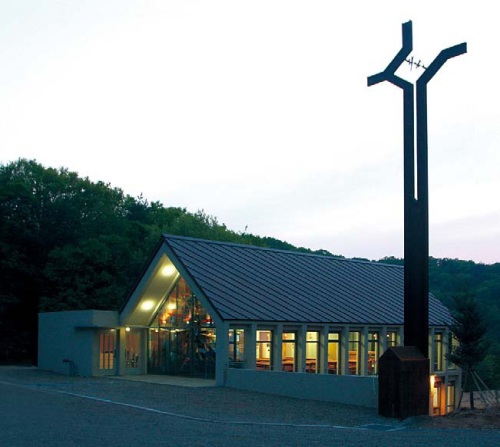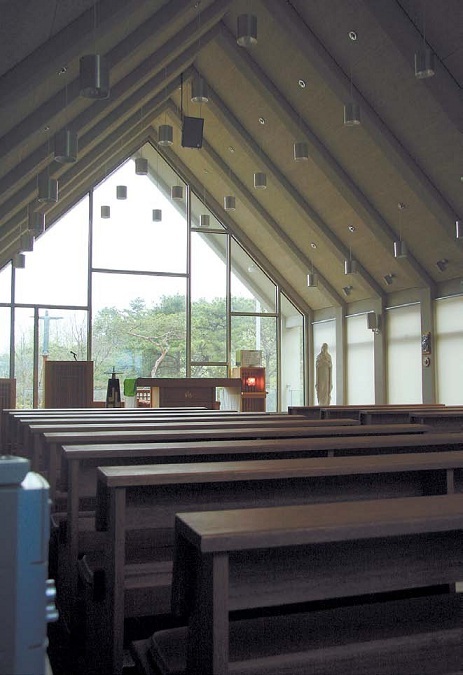 |
Seonggeo-san Catholic Church is located in Seonggeo-san shrine near Cheonan, South Chungcheong Province. Its primitive roof and transparent glass wall convey the meaning of a martyr’s life.(Photo by Park Jong Min) |
The Seonggeo-san Catholic Church is located on the Seonggeo-san shrine near Cheonan, South Chungcheong Province. The Seonggeo-san shrine is located two kilometers up along a mountain road. Nestled in the deep, isolated mountain, it is understandable that Korean Catholics hid here during the time of Catholic persecution. Every May, a wild flower festival is held here for a week ― the wild flowers are considered metaphors for the unnamed Catholic martyrs.
The site of the Seonggeo-san shrine is a village formed by Korean Catholics who sought refuge, fleeing religious persecution in the 19th century Joseon. According to records, it was originally a habitat for priest Adolphe-Nicolas Calais from the Society of Foreign Missions of Paris.
 |
The interior of Seonggeo-san Catholic Church, which affords views of the surroundings(Photo by Park Jong Min) |
We were given the opportunity to make a master plan for the total landscape of the shrine. Since this shrine was a place where persecuted Catholics gave up everyday life for their religious freedom, we reached the consensus that the word “life” would be the key word, in contrast to most other shrines that are related to martyrs or death.
Meeting the challenge of how to arrange and symbolize “life” within the space was the main objective of design. This small Catholic church would be the first project to be realized.
The church site is situated in a valley, facing a rectory on the entry path to the shrine. The first inspiration was to make a simple pitched roof to the valley. Since this type of roof represents the primitive shape of a home, it symbolizes the martyrs’ yearning for the homes they left behind. The pitched roof also symbolizes a shelter against humble nature ― a simplistic architectural definition. Furthermore, the roof represents a spiritual shelter during the days of religious persecution.
The second inspiration was to use transparent glass to open the main hall to nature. This would allow the worshippers to experience the same views that the ancestors had, without a church building. It was our intention that nature should be seen during Mass. This is the opposite of city parish cathedrals that achieve a centralized plan by blocking the urban view.
In conclusion, the open view in the hall and the primitive roof of the church were suggested for symbolic configuration to represent the people who lived in hiding. The 9-meter reconstructed cross on the right side of the church building was designed by sculptor Kim Jong-pil. It indicates the entrance to the shrine and the Catholic church.
 |
Mihn Hyun-jun |
By Mihn Hyun-jun










